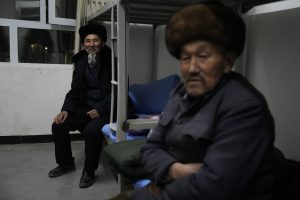A magnitude 7.1 earthquake in a remote part of China’s western Xinjiang region killed at least three people and caused extensive damage in freezing weather, officials said Tuesday while suggesting that the area’s sparse population contributed to the “very strong” quake’s low death toll.
The quake rocked Uchturpan county in Aksu prefecture shortly after 2 a.m., the China Earthquake Networks Center said. Rescue crews rushed to the area, with about 1,000 on hand by midday. By evening, authorities said three people had died and five were injured, two seriously, in the county, which is also called Wushi in Mandarin, China’s official language.
Rescue crews combed through the rubble. Emergency survival gear — including coats and tents to help the thousands of people who fled their homes — had arrived or were on their way, the official Xinhua News Agency said.
The quake’s epicenter was located in a mountainous area about 3,000 meters (9,800 feet) above sea level, Zhang Yongjiu, the head of Xinjiang Earthquake Administration, told a news conference.
“This 7.1 rating is very strong, but the death and injury situation is not severe,” Zhang said.
The area is populated mostly by Uyghurs, a Turkic ethnicity that is predominantly Muslim and has been the target of a state campaign of forced assimilation and mass detention. The region is heavily militarized, and state broadcaster CCTV showed paramilitary troops moving in before dawn to clear rubble and set up tents for those displaced.
Jian Gewa, a 16-year old student in Uchturpan, said he was in the bathroom when the quake began. The entire building shook violently.
“I just thought I had to get myself to safety as quickly as possible,” Jian said.
He had been evacuated to a school and was staying in a dorm room with his grandfather, joining about 200 others. Local officials said they planned to check houses’ stability before people could return.
Among the more than 120 buildings damaged, 47 houses had collapsed, the government of the Xinjiang Uygur Autonomous Region posted on its official Weibo social media account.
Officials said most of the houses that collapsed were in remote areas and were mainly built by residents. The new public housing recently built by the government did not collapse.
Associated Press journalists saw some walls had cracked or partially collapsed in the empty Aksu country village of Youkakeyamansu, a name transliterated in Mandarin from Uyghur. All residents had been evacuated to a shelter.
The mountainous Uchturpan county is recording temperatures well below freezing, with the China Meteorological Administration forecasting lows reaching negative 18 degrees Celsius (just below zero Fahrenheit) this week.
The county had around 233,000 people in 2022, according to Xinjiang authorities.
The quake downed power lines but electricity was quickly restored, Aksu authorities said. The Urumqi Railroad Bureau resumed services after 7 a.m. following safety checks that confirmed no problems on train lines. The suspension affected 23 trains, the bureau serving the Xinjiang capital said on its official Weibo account.
The U.S. Geological Survey said the area’s largest quake in the past century was also magnitude 7.1 and occurred in 1978, about 200 kilometers (124 miles) to the north of Tuesday’s epicenter.
Multiple aftershocks were recorded Tuesday, the strongest measured at 5.3 magnitude.
Tremors were felt hundreds of kilometers away.
Ma Shengyi, a 30-year-old pet shop owner in Tacheng, 600 kilometers (373 miles) from the epicenter, said her dogs started barking before she felt her apartment building shudder. Her neighbors ran downstairs. Ma rushed to her bathroom and started to cry.
“There’s no point in running away if it’s a big earthquake,” Ma said. “I was scared to death.”
Tremors also were felt in neighboring Kyrgyzstan and Kazakhstan. Videos posted on the Telegram messaging platform showed people in Almaty, Kazakhstan’s largest city, running downstairs in apartment blocks and standing in the street, some of them wearing shorts in the freezing weather. At least eight people were injured in Almaty, which until 1997 was the country’s capital. One of the reasons commonly cited for relocating the capital to the city now known as Astana was Almaty’s location in a seismically active area.
In Xinjiang and Kazakhstan, classes were suspended to allow children to recover from the shock.
Earthquakes are common in western China and Central Asia.
A 6.2 magnitude earthquake that struck Gansu province in December killed 151 people and was China’s deadliest quake in nine years. An earthquake in China’s Sichuan province in 2008 killed nearly 90,000.

































